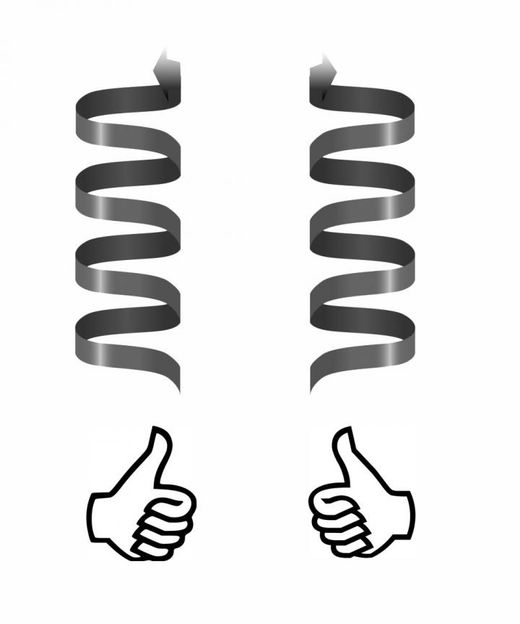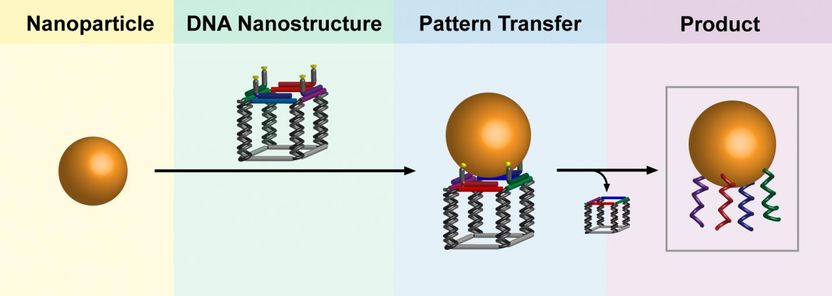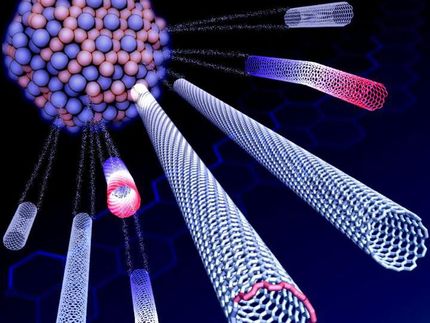Long-sought chiral anomaly detected in crystalline material
A study by Princeton researchers presents evidence for a long-sought phenomenon called the "chiral anomaly" in a metallic compound of sodium and bismuth. The additional finding of an increase in conductivity in the material may suggest ways to improve electrical conductance and minimize energy consumption in future electronic devices.

This sketch illustrates the notion of handedness, or chirality, which is found throughout nature. Most chemical structures and many elementary particles come in right- and left-handed forms.
Princeton University
"Our research fulfills a famous prediction in physics for which confirmation seemed unattainable," said N. Phuan Ong, Princeton's Eugene Higgins Professor of Physics, who co-led the research with Robert Cava, Princeton's Russell Wellman Moore Professor of Chemistry. "The increase in conductivity in the crystal and its dramatic appearance under the right conditions left little doubt that we had observed the long-sought chiral anomaly."
The chiral anomaly stems from the observation that chirality is ubiquitous in nature. For example, most chemical structures and many elementary particles come in chiral forms.
Early research leading up to the discovery that all elementary particles that have zero mass strictly segregate into left- and right-handed populations that never intermix.
A few decades later, theorists discovered that the presence of electric and magnetic fields ruins the segregation of these particles, causing the two populations to transform into each other with observable consequences.
This field-induced mixing, which became known as the chiral anomaly. Over the decades the anomaly has played an important if perplexing role in the grand quest to unify the four fundamental forces of nature.
Recent progress in the development of certain kinds of crystals known as "topological" materials has paved the way toward realizing this prediction, Ong said. In the crystal of Na3Bi, which is a topological material known as a Dirac semi-metal, electrons occupy quantum states which mimic massless particles that segregate into left- and right-handed populations.
To see if they could observe the anomaly in Na3Bi, Jun Xiong, a graduate student in physics advised by Ong, cooled a crystal of Na3Bi grown by Satya Kushwaha, a postdoctoral research associate in chemistry who works with Cava, to cryogenic temperatures in the presence of a strong magnetic field that can be rotated relative to the direction of the applied electrical current in the crystal. When the magnetic field was aligned parallel to the current, the two chiral populations intermixed to produce a novel increase in conductivity, which the researchers call the "axial current plume." The experiment confirmed the existence of the chiral anomaly in a crystal.
"One of the key findings in the experiment is that the intermixing leads to a charge current, or axial current, that resists depletion caused by scattering from impurities," Ong said. "Understanding how to minimize the scattering of current-carrying electrons by impurities -- which causes electronic devices to lose energy as heat -- is important for realizing future electronic devices that are more energy-efficient. While these are early days, experiments on the long-lived axial current may help us to develop low-dissipation devices."
Original publication
Other news from the department science

Get the chemical industry in your inbox
By submitting this form you agree that LUMITOS AG will send you the newsletter(s) selected above by email. Your data will not be passed on to third parties. Your data will be stored and processed in accordance with our data protection regulations. LUMITOS may contact you by email for the purpose of advertising or market and opinion surveys. You can revoke your consent at any time without giving reasons to LUMITOS AG, Ernst-Augustin-Str. 2, 12489 Berlin, Germany or by e-mail at revoke@lumitos.com with effect for the future. In addition, each email contains a link to unsubscribe from the corresponding newsletter.
Most read news
More news from our other portals
Last viewed contents

2060 The NIR Analyzer | NIR spectrometers | Metrohm Prozessanalytik
Gold nanoparticles to find applications in hydrogen economy
Category:Arsenic_minerals
Nicofuranose
Immunoglobulin_superfamily
Hydrogen_sulfide

A 'printing press' for nanoparticles
Merck Completes Squeeze-Out of AZ Electronic Materials
Noble gas molecule discovered in space






























































